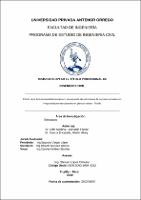Mostrar el registro sencillo del ítem
Efecto de la bidireccionalidad sísmica en la respuesta de estructuras de concreto armado con irregularidades estructurales en planta y altura - Trujillo
| dc.contributor.advisor | López Otiniano, Stewart | |
| dc.contributor.author | Ulffe Medina, Leonardo Fabiano | |
| dc.contributor.author | García Encalada, Ahslly Hilary | |
| dc.creator | Ulffe Medina, Leonardo Fabiano | |
| dc.date.accessioned | 2022-09-02T20:24:04Z | |
| dc.date.available | 2022-09-02T20:24:04Z | |
| dc.date.issued | 2022 | |
| dc.identifier.uri | https://hdl.handle.net/20.500.12759/9461 | |
| dc.description.abstract | Actualmente nuestra normativa peruana de diseño sísmico considera que la acción sísmica actúa independientemente en dos direcciones ortogonales predominantes (x, y). Sin embargo, los eventos sísmicos tienen un comportamiento bastante aleatorio e imponen solicitaciones en cualquier dirección en las estructuras. En la presente investigación se realiza el estudio de la respuesta en edificaciones de concreto armado con irregularidad en planta y altura. Para ello, se ha realizado el análisis tiempo historia lineal (ATHL) de estas imponiendo solicitaciones sísmicas en dos direcciones ortogonales (BIDIRECCIONALIDAD). Así, se obtiene la respuesta estructural con variaciones de ángulo de incidencia de 10° es decir se rotarán de 0° a 360° y se compara con la respuesta obtenida del análisis unidireccional. Los resultados obtenidos muestran que el análisis tradicional subestima las respuestas de las estructuras. Se obtiene variaciones de hasta 50% y 75% para las estructuras con irregularidad en altura (geometría vertical) y planta (torsión) respectivamente. | es_PE |
| dc.description.abstract | Currently our Peruvian seismic design standards consider that seismic action acts independently in two predominant orthogonal directions (X, Y). However, seismic events have a quite random behavior and impose stresses in any direction on structures. In the present investigation, the response of reinforced concrete buildings with irregularity in plan and height is studied. For this purpose, the linear time-history analysis (ATHL) of these buildings has been carried out by imposing seismic stresses in two orthogonal directions (BIDIRECTIONALITY). Thus, the structural response is obtained with variations in the angle of incidence of 10°, i.e. they are rotated from 0° to 360° and compared with the response obtained from the unidirectional analysis. The results obtained show that the traditional analysis underestimates the responses of the structures. Variations of up to 50% and 75% are obtained for structures with irregularity in height (vertical geometry) and plan (torsion) respectively | en_US |
| dc.description.uri | Tesis | es_PE |
| dc.format | application/pdf | es_PE |
| dc.language.iso | spa | es_PE |
| dc.publisher | Universidad Privada Antenor Orrego | es_PE |
| dc.relation.ispartofseries | T_CIVIL_2108 | |
| dc.rights | info:eu-repo/semantics/openAccess | es_PE |
| dc.rights.uri | https://creativecommons.org/licenses/by/4.0/ | es_PE |
| dc.source | Universidad Privada Antenor Orrego | es_PE |
| dc.source | Repositorio Institucional - UPAO | es_PE |
| dc.subject | Bidireccionalidad | es_PE |
| dc.subject | Angulo de Incidencia Geométrica | es_PE |
| dc.title | Efecto de la bidireccionalidad sísmica en la respuesta de estructuras de concreto armado con irregularidades estructurales en planta y altura - Trujillo | es_PE |
| dc.type | info:eu-repo/semantics/bachelorThesis | es_PE |
| thesis.degree.level | Título Profesional | es_PE |
| thesis.degree.grantor | Universidad Privada Antenor Orrego. Facultad de Ingeniería | es_PE |
| thesis.degree.name | Ingeniero Civil | es_PE |
| thesis.degree.discipline | Ingeniería Civil | es_PE |
| dc.subject.ocde | https://purl.org/pe-repo/ocde/ford#2.01.00 | es_PE |
| renati.advisor.orcid | https://orcid.org/0000-0003-1694-4212 | es_PE |
| renati.author.dni | 72388301 | |
| renati.author.dni | 71089928 | |
| renati.advisor.dni | 71802352 | |
| renati.type | https://purl.org/pe-repo/renati/type#tesis | es_PE |
| renati.level | https://purl.org/pe-repo/renati/level#tituloProfesional | es_PE |
| renati.discipline | 732016 | es_PE |
| renati.juror | Vargas López, Segundo | |
| renati.juror | Narváez Aranda, Ricardo | |
| renati.juror | Geldres Sánchez, Carmen | |
| dc.publisher.country | PE | es_PE |
Ficheros en el ítem
Este ítem aparece en la(s) siguiente(s) colección(es)
-
Ingeniería Civil [1260]


